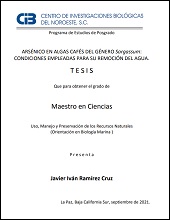| dc.contributor.advisor | Méndez Rodríguez, Lía Celina | |
| dc.contributor.advisor | Serviere Zaragoza, Elisa | |
| dc.contributor.author | Ramírez Cruz, Javier Iván | |
| dc.date.issued | 2021 | |
| dc.identifier | https://cibnor.repositorioinstitucional.mx/jspui/handle/1001/2676 | |
| dc.identifier.uri | http://dspace.cibnor.mx:8080/handle/123456789/3130 | |
| dc.description.abstract | "Concentraciones de arsénico (As) por arriba del máximo aceptable por la Norma Oficial Mexicana (NOM-127-SSA1-1994), de 25 µg L-1, han sido registradas en pozos de agua subterránea en zonas áridas de Baja California Sur. La ingesta de agua contaminada representa un problema de salud pública. Las macroalgas cafés (Phaeophyceae, Ochrophyta), particularmente las del género Sargassum, han demostrado ser más eficientes para la remoción de iones metálicos comparadas con las algas verdes (Chlorophyta) o rojas (Rhodophyta). La capacidad de las algas para remover As del agua puede variar en función de la temperatura y pH del agua, la dosis o cantidad de alga empleada y el tiempo de contacto alga/As. El presente estudio tiene como objetivos 1) conocer el intervalo de la concentración de arsénico que se encuentra en especies pelágicas de sargazo y 2) conocer mediante una revisión bibliográfica que condiciones químicas, especialmente de pH, pueden mejorar la capacidad que tiene el sargazo para remover arsénico del agua. Para el primer objetivo se realizaron muestreos de sargazo pelágico de arribazón en Puerto Morelos, Quintana Roo durante el periodo de junio a agosto de 2019. Se determinó la concentración de As mediante Espectrofotometría de absorción atómica por generación de hidruros. Los resultados indican diferencias significativas en las concentraciones de As entre especies, mes de colecta y su interacción (p<0.05). En relación al segundo objetivo, los estudios consultados sugieren que a un pH entre 6 y 7 el sargazo presenta una mayor capacidad de remoción de As. En este contexto, se resalta que, aunque las algas del género Sargassum de manera natural adsorben arsénico del medio, esta capacidad se puede ver optimizada a pH ligeramente ácidos." | es |
| dc.format | pdf | es |
| dc.language.iso | spa | es |
| dc.publisher | Centro de Investigaciones Biológicas del Noroeste, S.C. | es |
| dc.rights | Acceso abierto | es |
| dc.subject | arsénico, sargazo, pH | es |
| dc.subject | arsenic, sargassum, pH | es |
| dc.subject.classification | ALGOLOGÍA (FICOLOGÍA) | es |
| dc.title | ARSÉNICO EN ALGAS CAFÉS DEL GÉNERO Sargassum: CONDICIONES EMPLEADAS PARA SU REMOCIÓN DEL AGUA | es |
| dc.type | masterThesis | es |
| dc.dirtesis.grado | Maestría en Ciencias en el Uso, Manejo y Preservación de los Recursos Naturales | es |
| dc.dirtesis.disciplina | Biología Marina | es |
| dc.dirtesis.universidad | Centro de Investigaciones Biológicas del Noroeste, S.C. | es |
| dc.dirtesis.facultad | Posgrado en Recursos Naturales | es |
| dc.description.abstracten | "Arsenic (As) concentrations above the maximum acceptable by the Official Mexican Standard (NOM-127-SSA1-1994) of 25 µg L-1, have been recorded in groundwater wells in arid zones of Baja California Sur. The ingestion of contaminated water represents a public health problem. The brown macroalgae (Phaeophyceae, Ochrophyta), particularly those of the genus Sargassum have been shown to be more efficient for the removal of metal ions compared to the green (Chlorophyta) or red (Rhodophyta) algae. The ability of algae to remove As from water can vary depending on the temperature and pH of the water, the dose or amount of algae used and the time of contact with algae / As. The present study aims 1) to know the range of the arsenic concentration found in pelagic species of sargassum and 2) to know through a bibliographic review that chemical conditions, especially pH, can improve the ability of sargassum to remove arsenic from the water. For the first objective, samplings of pelagic sargassum were carried out in Puerto Morelos, Quintana Roo during the period from June to August 2019. The concentration of As was determined by means of atomic absorption spectrophotometry by generation of hydrides. Regards the first objective, the results indicate significant differences in As concentrations between species, collection month and their interaction (p <0.05). About the second objective, the consulted studies suggest that at a pH between 6 and 7 sargassum has a greater capacity to remove As. In this context, it is highlighted that, although the algae of the genus Sargassum naturally adsorb arsenic from the environment, this capacity can be optimized at a slightly acidic pH." | es |

